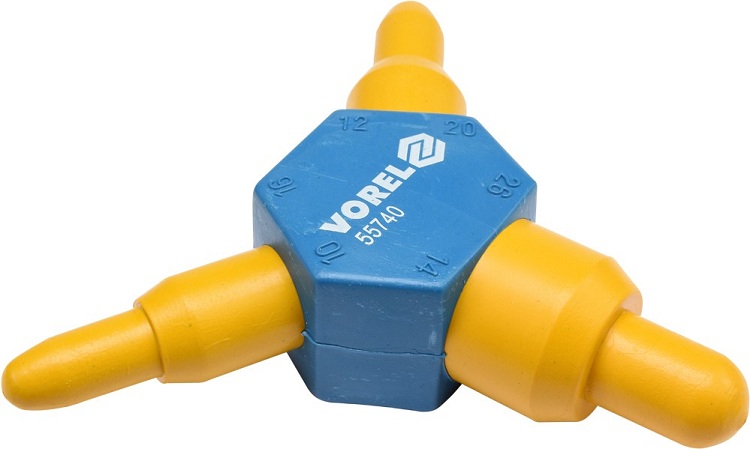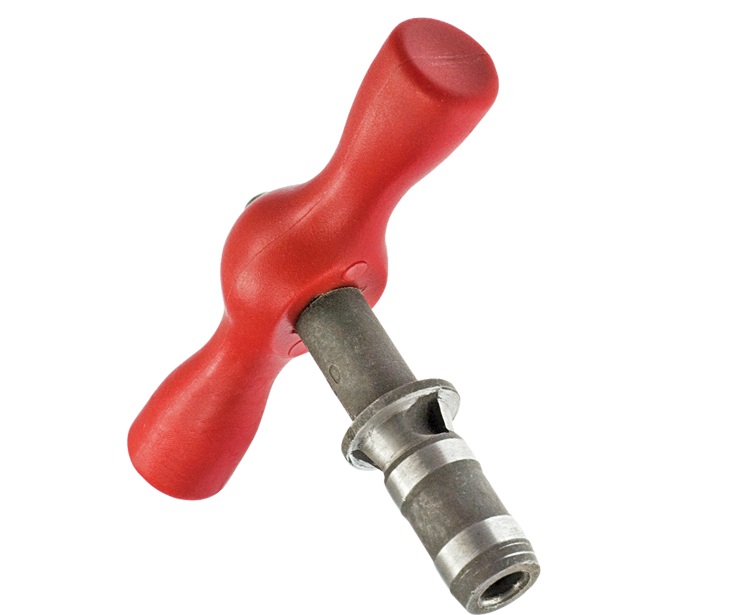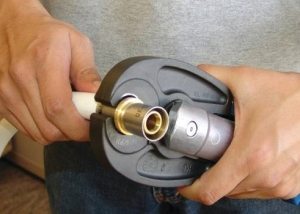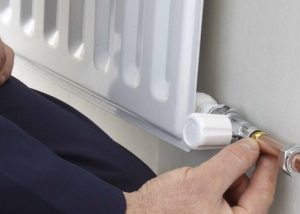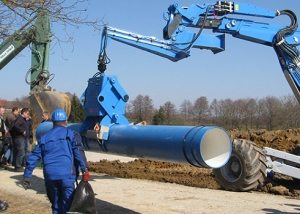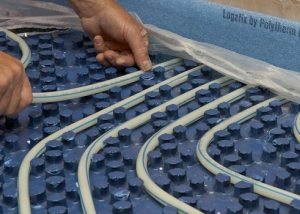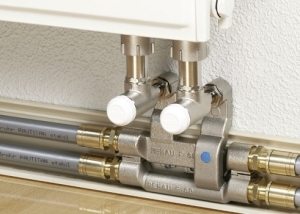Plastic pipes - this is one of the most popular options for the installation of plumbing and heating communications. They are distinguished by high performance characteristics, including: corrosion resistance, temperature resistance, ease of installation. To install them use special tools. One of these is a calibrator for plastic pipes.
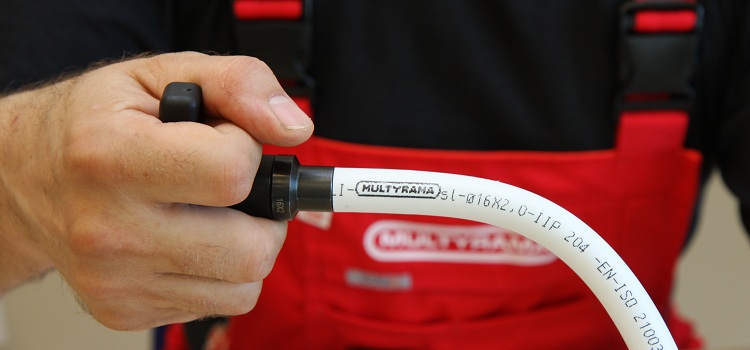
In order for the connection of metal-plastic pipes to be reliable, it is necessary to process their ends with a calibrator
Content
Main characteristics
A calibrator is a special device that performs three main functions:
- calibration
- chamfering;
- correction of the shape of the end of the pipe after cutting and other operations.
These measures allow you to prepare plastic pipes for the installation of connecting elements. For joining, as a rule, crimp fittings or press models are used.
Today, you can find several types of this device, which are used for pipes with different cross-sectional indicators. When choosing a calibrator, it is recommended to pay attention to its labeling. The diameter of the device can be 12, 16, 20, 26, 33 mm.
Such devices facilitate a gradual transition between pipeline elements that are of different sizes. The calibrator includes the following parts:
- case made of polypropylene (PP);
- plate with a cutting edge (knife).
Consider the main advantages of using such a device when installing metal-plastic structures:
- compactness;
- savings due to the fact that the trimming of uneven ends of pipeline parts is excluded;
- ease of installation;
- high speed of work;
- device reliability.
It is also worth noting that the device is symmetrical for convenient work. Using the calibrator allows you to simplify the installation of the pipeline structure and conduct it as correctly as possible.
The principle of operation of the device
The calibration of plastic pipes is carried out in a certain sequence. First of all, it is necessary to cut the pipe part at a right angle to its longitudinal axis. The cut should be as vertical as possible, since the quality of the connections and, accordingly, the operational characteristics of the entire communication depends on this. If you do not want to get a leak at the junction in the future, then you must strictly adhere to this rule.
Important! The fitting of the device must be introduced strictly along the axis. Any deviations are not allowed.
In addition, it is strictly forbidden to use the calibrator when installing communications, the cross-sectional indicators of which differ from the permissible for using this device. The calibrator can be used for metal-plastic as well as plastic pipes made of polyethylene (PE).
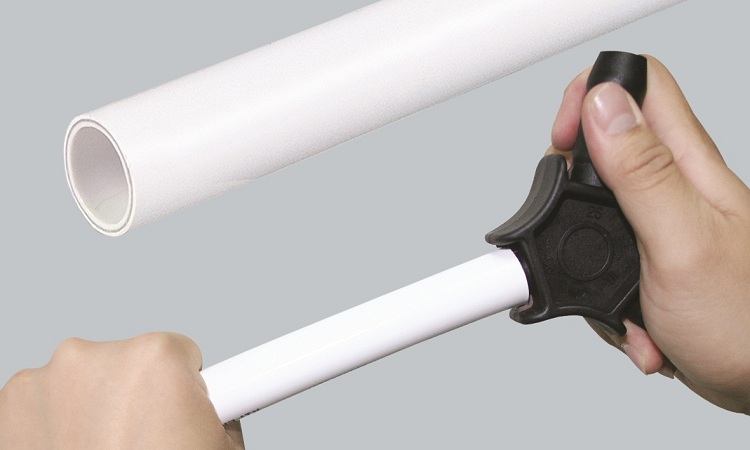
The pipe is put on a protrusion of a calibrator of a suitable diameter, after which the tool is rotated several times around the axis
It is allowed to push the pipe over the fitting until the insert with the cutting edge cuts into the material of the inner layer.Then the tool is rotated around its axis several times. The companies that manufacture these devices guarantee the quality of the calibrator only if all conditions of storage, transportation and installation are met.
Types of Calibrators
To date, there are two main types of calibrators that are used in the installation of plastic pipes:
- plastic;
- devices with a bevel picker.
- Plastic Such calibrators are used for flaring metal-plastic pipes. And also with the help of them it is possible to align the oval ends of the metal-plastic parts of the pipeline, which appear in the process of cutting pipes. Alignment by means of a calibrator facilitates the correct installation of connecting fittings. Plastic devices are made of durable, high-quality plastic, which, among other things, is resistant to abrasion.
- Devices with a faskosnimatel. They are used for flaring metal-plastic pipes, as well as for chamfering them. With the help of such devices, the installation of connecting elements is carried out and unwanted burrs from the ends of the pipes are eliminated, and they (like the previous view) are used to align the oval ends of the plastic pipes.
Both of these types are used in the installation of metal-plastic communications. Calibrators with a bevel pick for metal-plastic pipes provide high accuracy of installation work. The choice of device depends on the indicator of the cross-section of the pipes, as well as on the features of the installation work.
Recommendations for use
There are several important rules that you should pay attention to before using the calibrator:
- such a device as a calibrator for pipes is strictly forbidden to operate when installing communications made of metal-plastic, the cross-sectional parameters and dimensions of which do not correspond to those indicated on the device marking;
- it is forbidden to use this device for straightening metal-plastic pipes;
- after 250 calibration steps, the tool blades become dull. Therefore, they must be periodically ground to the desired state. A file or plain sandpaper is perfect for this procedure. After that, they can be used for further calibration.
- Calibrator fittings should be protected from mechanical damage and high temperatures. Since this may affect its performance.
Important! It is advisable to store the calibrator in a dark place in order to prevent direct sunlight.
Installation of metal-plastic communications using a calibrator is quite simple. Therefore, it will not be difficult to learn the correct algorithm for doing the work.
Experts recommend that before direct installation of the pipeline structure using the calibrator, watch special training videos on this topic. This will avoid undesirable errors and conduct the correct installation of metal-plastic communication.
Correct work with the calibrator
Learning to use this tool is quite simple. To work with him, no special construction knowledge is required, however, you must be careful and study the principle of its operation, as well as some of the nuances of installation.
Consider the main stages of working with this device:
- First you need to make sure that the section of the metal-plastic pipe is made at an angle of 90 °.
- Perform a calibrator compatibility test for a specific pipe diameter.
- After that, you need to insert the device connector into the pipe.Any distortions in this case are unacceptable, since the incorrect position of this device entails leaks at the pipe joints in the future.
- Then you need to check whether the sharp edges of the knives fall on the inner chamfer.
- At the end, the device rotates around its axis.
Thus, the correct calibration of the pipes is carried out. The calibrator contributes to reliable and high-quality pipe connection with fittings. However, this is possible only if all the rules for storage, transportation and installation are observed.
If you are not sure that you can make the correct installation of a metal-plastic pipeline using a calibrator, it is recommended to contact specialists.
